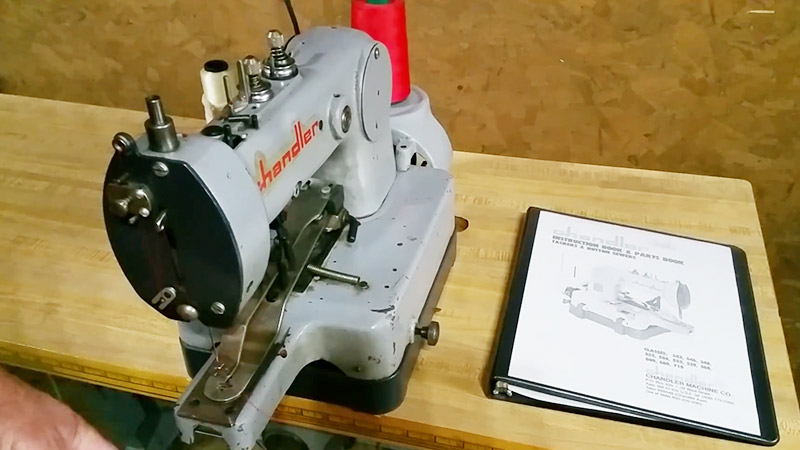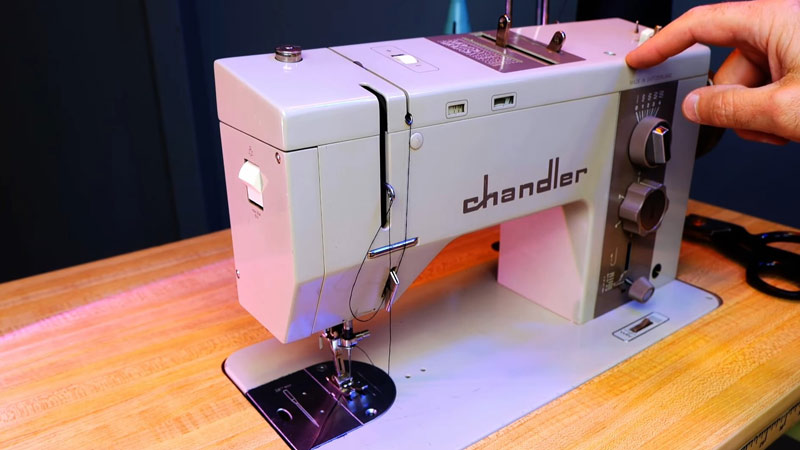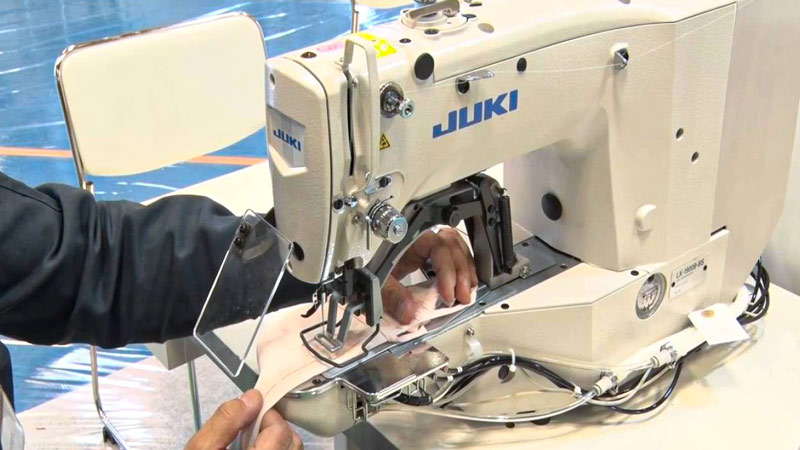A tacker sewing machine, often overlooked in the realm of sewing technology, is a powerhouse in various industrial sectors.
This specialized machine excels in a singular but vital function: creating tacking stitches, also known as temporary stitches.
Designed for speed and efficiency, tacker sewing machines rapidly generate closely spaced, short stitches, temporarily bonding layers of fabric or materials before final assembly or bonding.
Their programmable nature allows for customization, adapting to specific applications, while their versatility extends their utility to fabrics, leather, plastics, and more.
In an era of automation, tacker machines have evolved to streamline production processes, making them indispensable in the textile, automotive, and manufacturing industries, among others.

What Is a Tacker Sewing Machine? -Key Features and Characteristics
A tacker sewing machine, also known as a tack sewing machine or simply a “tacker,” is a specialized type of sewing machine designed for a specific purpose – creating tacking stitches.
These machines are commonly used in the textile and garment industry, as well as in various other industries that require temporary stitching for holding materials together before permanent sewing or bonding is performed.
Tacking stitches, sometimes referred to as “tacks” or “temporary stitches,” are short, closely spaced stitches used to temporarily hold fabric layers or other materials in place.
These stitches are typically made with a contrasting thread color to make them easily distinguishable from permanent stitches, and they are designed to be easily removable once they have served their purpose.
Here are some key features and characteristics of a tacker sewing machine:
Stitch Type
Tacker sewing machines produce a specific type of stitch known as a “tack stitch.” These stitches are often very short and closely spaced, creating a series of small, secure connections.
Speed and Efficiency
Tacker machines are designed for high-speed operation. They can rapidly create multiple tack stitches, making them ideal for mass production in industries where speed and efficiency are crucial.
Programmability
Many modern tacker machines are computerized and programmable. This means that the operator can adjust the stitch length, tack spacing, and other parameters to suit the specific application.
Materials
Tacker sewing machines can work with a wide range of materials, including fabrics, leather, plastics, and more. They are commonly used in the production of garments, shoes, bags, automotive upholstery, and other products.
Versatility
While tacker machines excel at creating temporary tack stitches, some models can also be used for permanent stitching, giving them a degree of versatility.
Automation
Automation features, such as automatic thread trimming and thread tension control, are often integrated into tacker sewing machines to further enhance their efficiency and reduce operator fatigue.
Specialized Applications
Tacker machines can be used for various specialized applications, such as attaching labels, securing pockets, adding pleats, and more.
They are also employed in industries where bonding materials with adhesives or heat sealing is combined with tacking stitches for added strength.
What Is a Tacker Sewing Machine Used For?

A tacker sewing machine is primarily used for creating tacking stitches, which are temporary stitches used to hold fabric layers or other materials together temporarily.
These machines have various applications in different industries, including:
Garment Manufacturing
Tacker sewing machines are commonly used in the garment industry to attach labels, secure pockets, and reinforce stress points in clothing items. They are essential for creating durable and aesthetically pleasing garments.
Shoe Manufacturing
In the production of shoes and footwear, tacker sewing machines are used to attach straps, reinforce seams, and secure various components together before final assembly.
Bag and Luggage Production
Tacker sewing machines play a crucial role in the assembly of bags, backpacks, and luggage items. They are used to reinforce handles, attach zippers, and secure pockets.
Automotive Upholstery
Tacker sewing machines are employed in the automotive industry to secure upholstery materials, such as fabric or leather, for car seats and interiors. They ensure that the upholstery remains in place and withstands the rigors of daily use.
Industrial Textiles
Tacker sewing machines are used in the production of industrial textiles like canvas, tarps, and heavy-duty fabric products. They reinforce seams and edges, providing durability and strength to the final product.
Temporary Stitching
These machines are essential when temporary stitching is required for pattern alignment, positioning, or testing before final sewing, bonding, or assembly. The temporary stitches can be easily removed when they have served their purpose.
Custom Sewing Applications
Tacker sewing machines are also used in various custom sewing applications, such as adding pleats, securing patches, and creating decorative stitching.
What Is a Chandler Sewing Machine?

A Chandler sewing machine is an industrial-grade sewing machine manufactured by Chandler Machine USA, a company with over a century of experience in producing sewing machines and related equipment.
These machines are highly regarded for their reliability and versatility, making them popular choices in various industries, including garment manufacturing, dry cleaning, laundry, upholstery, and more.
Chandler sewing machines encompass a wide range of types and models to suit different sewing needs.
Some of the notable types of Chandler sewing machines include:
- Button Sewers: These machines are designed for precise and efficient button sewing, offering various stitch patterns and button sizes.
- Single Needle Lockstitch Machines: Ideal for sewing straight stitches on lightweight to medium-weight fabrics, these machines feature adjustable stitch length and a reverse function.
- Portable Overlock and Coverstitch Machines: These machines excel at creating overlock and coverstitch seams on knit fabrics, offering features like differential feed and adjustable stitch width.
- Industrial Overlock Machines: Built for sewing overlock seams on heavy-duty fabrics, these machines boast high-speed operation and durability.
- Blindstitch Machines: These machines are used for creating invisible hems on garments, with adjustable stitch depth and skip stitch functionality.
- Upholstery and Heavy-Duty Sewing Machines: Chandler offers machines capable of handling thick and tough materials like leather, canvas, and vinyl, thanks to their powerful motors and large bobbins.
- Sewing Machine Motors and Stands: These accessories enhance sewing machine performance and stability, available in various speed and voltage options.
- Cutting Machines and Scissors: Chandler provides cutting tools for precise fabric and thread cutting, featuring sharp blades and ergonomic handles.
- Steamers: Chandler’s steamers effectively remove wrinkles and creases from fabrics with high-temperature and high-pressure steam.
- Irons: These devices are designed for smooth and neat fabric pressing, offering adjustable temperature and steam settings.
- Fiber Boards: Chandler’s fiber boards provide a flat and sturdy surface for cutting and pressing fabrics, available in different thicknesses and dimensions.
- Swatch Cutters: These machines are used to cut fabric samples or swatches for display or testing purposes, coming in various sizes and shapes.
- Swatch Cutter Blades and Sharpening: Chandler offers accessories to maintain the sharpness and efficiency of swatch cutter blades.
What Is a Bar Tacking Sewing Machine?

A bar-tacking sewing machine is a specialized type of sewing machine designed primarily for creating bar-tack stitches.
Bar tack stitches are short, closely spaced, and often reinforced stitches that are used to reinforce stress points, attach belt loops, secure pockets, and perform other critical sewing tasks in various industries, including garment manufacturing, automotive upholstery, and heavy-duty textile applications.
Here are some key features and characteristics of a bar tacking sewing machine:
Stitch Type
The primary function of a bar-tacking sewing machine is to create bar-tack stitches. These stitches are often characterized by their short length, high density, and zigzag or satin-like appearance.
Reinforcement
Bar tack stitches are employed to reinforce specific areas of a garment or product, such as the corners of pockets, belt loops, and buttonholes, to withstand wear and tear.
Precision and Durability
Bar tack sewing machines are engineered for precision and durability. They can create consistent and strong stitches even when sewing through multiple layers of fabric or heavy materials.
Versatility
These machines are versatile and can be used for a variety of applications, including sewing on labels, attaching patches, reinforcing seams, and more.
Programmability
Many modern bar tacking sewing machines are computerized and programmable. This allows operators to adjust stitch length, width, and other parameters to suit specific sewing tasks and patterns.
Automatic Functions
Bar tacking machines often come with automatic features such as thread trimming, backtracking (reversing stitches), and thread tension control to streamline the sewing process and improve efficiency.
Industrial and Heavy-Duty Use
Bartacking sewing machines are commonly found in industrial settings where durability and reliability are essential. They can handle various fabrics, including lightweight textiles and heavy-duty materials like canvas or denim.
Customization
These machines can create bar tack stitches in different patterns and styles, adding both functional reinforcement and decorative elements to products.
FAQS
What’s the difference between a tacker sewing machine and a regular sewing machine?
Tacker sewing machines specialize in creating temporary tacking stitches for holding materials together temporarily.
Regular sewing machines are more versatile and used for a wide range of permanent sewing tasks.
Can tacker sewing machines be used for permanent stitching as well?
Some tacker machines have dual functionality and can be used for both temporary tacking and permanent stitching.
What industries rely heavily on tacker sewing machines?
Tacker sewing machines are commonly used in the garment, shoe manufacturing, bag making, and automotive upholstery industries where temporary stitching is essential during the production process.
Are tacker sewing machines suitable for home use?
Tacker sewing machines are typically industrial or commercial-grade machines and are not commonly used for home sewing.
How are tacker sewing machines programmed for specific applications?
Modern tacker sewing machines can be programmed through their control panels or software interfaces.
Conclusion
A tacker sewing machine, though often overshadowed by its more versatile counterparts, plays a pivotal role in various industries by excelling in a specialized task – the creation of temporary tacking stitches.
These short, closely spaced stitches serve as the initial bond, holding fabric layers or materials together before permanent sewing or bonding takes place.
Renowned for their speed, precision, and programmability, tacker sewing machines cater to the demands of high-volume production, particularly in garment manufacturing, automotive upholstery, and bag production.
Their adaptability, whether for creating temporary stitches or even some permanent ones, underscores their versatility in enhancing efficiency and product quality.
As industries evolve, tacker sewing machines remain indispensable tools in the ever-changing landscape of textile and material assembly.
Leave a Reply